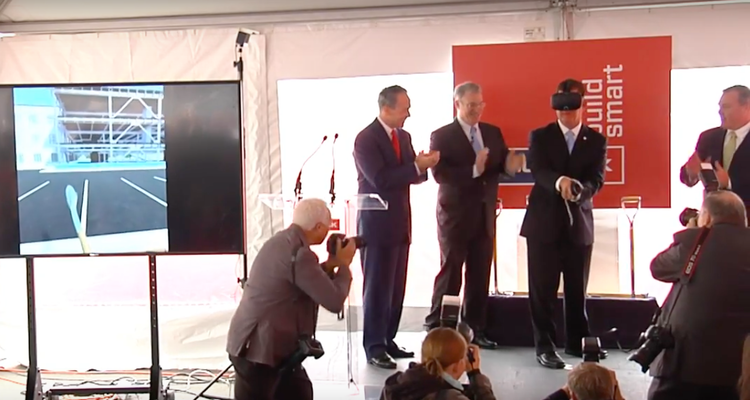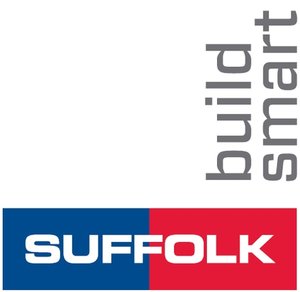
Ever since the invention of photography, the mundane ritual of the groundbreaking has been a symbolic staple in this industry, heralding the start of a new project, and the promise of economic benefits for workers, owners, future tenants or users, and the surrounding community.
All good things, to be sure. But captivating? Well, no.
But that was before Oct. 11, when Boston-based Suffolk Construction moved our industry’s cheese, spicing up the traditional shovel ceremony with a modern tech twist. That bright morning, Suffolk CEO John Fish and Boston Mayor Marty Walsh took part in a “virtual groundbreaking” to mark the start of construction on a $51-million, 38,000-sq-ft addition and complete interior renovation at Suffolk’s downtown headquarters.
Fish, Mayor Walsh, and Suffolk Northeast President Angus Leary (aka “Innovation Man”, see below) all donned virtual reality (VR) headsets at the event, symbolically turning dirt with an imaginary shovel while attendees viewed an a animation of the new structure being erected. To be sure, the activity may have seemed simple, and was not likely to win an Oscar for special effects. But that masked the intense effort that went into creating the new marketing tool and the tension behind its high-profile debut.
“Honestly, this is the first ‘virtual groundbreaking’ of its kind that any of us has heard of”
“Honestly, this is the first ‘virtual groundbreaking’ of its kind that any of us has heard of,” said Kevin Bredeson, Suffolk’s new VP of virtual design and construction, and a former VDC champion and tech veteran at Gilbane, Mortenson, and Pepper Construction. “When our CEO came to us and asked if we could do this, we weren’t sure. But we were all game to try. We only had three weeks to pull it together, but in the end, I think all of us — including the Mayor — were pleased with how it turned out. And the VR tools really engaged the crowd, the press, our partners on the project, employees and local officials.”
Working on that accelerated and firm deadline, Bredeson’s team enlisted year-old immersive VR specialist Theia Interactive to create the virtual experience it was seeking, ASAP. Based in Chico CA, Theia built the interactive animation using Unreal Engine’s software platform designed specifically for the HTC Vive headset.
“This virtual groundbreaking event marks an important milestone for Suffolk, and is symbolic of our ‘Build Smart’ approach and how we think differently [to] push the boundaries of what is possible on our projects,” said CEO Fish, who also serves as Suffolk’s chairman. “Our team is fully committed to transforming the construction experience for our clients, and leveraging state-of-the-art technologies and processes,” he added from the dais.
For his part, Mayor Walsh seemed happy with the VR experience, but was even more excited by Suffolk’s decision to stay in Boston while expanding — in keeping with recent national trends boosting existing urban centers. “Twenty-five years ago, we saw a lot of companies move from Boston to the suburbs; today, we are seeing that reversal,” noted Walsh, who this fall already has presided over two other ceremonies marking downtown commitments by Autodesk and GE. Praising Suffolk, the mayor added, “Today, we have a person and a company willing to invest $51 million here without asking for one penny in subsidies from the state or any government entity.”
Lean, collaborative, light-hearted
Founded in 1982, Suffolk today is a national, privately held general contractor with 1,550 employees and an estimated $2.5 billion in annual revenues. Its expanded headquarters will include collaborative workspaces, an amphitheater, a new employee cafeteria, fitness and wellness center, second-floor terrace and an outdoor basketball court. It will also feature an Innovation Lab where new and existing technologies will be tested for the field. Construction is currently underway, with the new addition to be completed by October 2017. The complete interior renovation will be completed December 2018.
Of note, the firm views its increasing use of VDC as going hand-in-glove with its ongoing commitment to use Lean Construction principles to eliminate waste and increase efficiencies via educated collaboration. For example, VR and AR are used not just for marketing purposes, but also “to immerse clients in the building experience and identify any unforeseen issues before breaking ground,” says the company.
Now, even that groundbreaking can be virtual. And marketers across the industry are taking note.
- Fun guy: Below, meet Suffolk’s NE President Angus Leary, aka “Innovation Man.”




Discussion
Be the first to leave a comment.
You must be a member of the BuiltWorlds community to join the discussion.